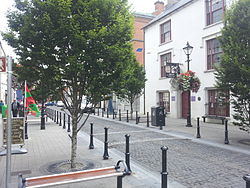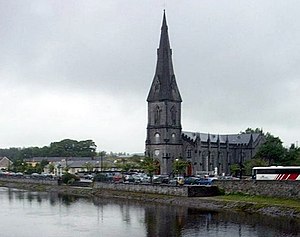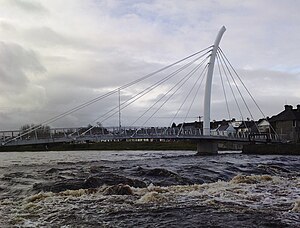Ballina
| Ballina Irish: Béal an Átha | |
| County Mayo, County Sligo | |
|---|---|
 Pearse Street, Ballina | |
| Location | |
| Grid reference: | G240192 |
| Location: | 54°7’0"N, 9°10’0"W |
| Data | |
| Population: | 10,361 (2011) |
| Local Government | |
| Council: | Mayo |
Ballina is a town in north County Mayo. It lies at the mouth of the River Moy near Killala Bay, in the Moy valley and Parish of Kilmoremoy, with the Ox Mountains to the east and the Nephin Beg mountains to the west. The town straddles the River Moy, which here forms the county border with Sligo. It also occupies two baronies: Tirawley on the west bank of the Moy and Tireragh on its east banks. The town's name is from the Irish Béal an Átha, meaning "mouth of the ford".
The population of Ballina is 10,361 according to the 2011 census (including environs it is 11,086) and is Mayo's second largest town after Castlebar.
History
According to Encyclopædia Britannica the first signs of settlement on the site of the town dates from around 1375 when an Augustinian friary was founded. Belleek, now part of the town, pre-dates the town’s formation, and can be dated back to the late 15th century, or early 16th century. However, what is now known as Belleek Castle was built in 1831. Ballina was officially established as a town in 1723 by O'Hara, Lord Tyrawley.
Belleek Estate
The Belleek estate once occupied lands from the Moy River to the modern-day Killala Road. This included part of the ‘Old French Road’ which General Humbert marched on from Killala, and beside part of which in the Killala Road-Belleek area was Belleek’s reservoir – presumably destroyed in the construction of Coca-Cola’s ‘Ballina Beverages’ factory; the ‘Old French Road’ is now closed off at that point.
General Humbert and the French Landing - 1798
The Centenary memorial (the Humbert Monument) was dedicated on 11 May 1898 to commemorate the 100th anniversary of the French landing at Killala in support of the Irish Rebellion of 1798. The monument was originally sculptured by a Dublin Craftsman but in recent years it has been restored locally. The figure on the monument is not Humbert but Mother Ireland. Maud Gonne unveiled the monument, and at the unveiling event famously poured water over another speaker's (an IRB member) head. The monument was moved to its current location on Humbert Street in 1987, where is was re-dedicated by Maud Gonne's son, Seán MacBride.
Megalithic tomb
The Dolmen of the Four Maols is located on 'Primrose Hill' behind Ballina's Railway Station. The dolmen dates from c.2,000 B.C. and is sometimes called locally the 'Table of the Giants'. Legend has it that the dolmen is the burial place of the four Maols. The four Maols murdered Ceallach, a 7th-century Bishop of Connaught and were hanged at Ardnaree - the Hill of Executions. Tradition says that their bodies were buried under the dolmen.[2]
Architecture, planning, and housing

The town has some notable architecture, including the 15th-century Moyne Abbey, and St Muredach's Cathedral, which is the Cathedral Church of the Roman Catholic Diocese of Killala. Work on the Cathedral began in 1827. The stone was quarried locally and the roof and ceiling were completed before the Great Famine (1845). The spire was completed in 1855 and by 1875 the organ had been commissioned.
Ballina has many listed buildings including Georgian Housing on the Banks of the Moy, the Ice House Building which has been converted into an exclusive hotel,[1] and the former provincial bank, which now houses the Jackie Clarke Museum. The streets of Ballina consist mainly of three and four-storey Georgian and Victorian buildings, though the structures of several buildings are actually far older.
Transport links
Roads
The N26 is the main road to Dublin. It leaves the town south to Foxford, and after Swinford joins the N5 to Dublin. The N59 comes from Belmullet and Crossmolina in the west, goes through the town to Sligo to the northeast. The R314 is a regional road to Killala, and then Ballycastle. The R294 goes to south County Sligo via 'the Windy Gap' in the Ox Mountains. It is used as an alternative route to Dublin, via Tubbercurry and Boyle.
Bridges
There are two main bridges straddling the Moy in the town centre. The first, the Armstrong and West, or Lower bridge, was built in 1835. The second, the Hamm bridge or Upper bridge, was built in the following year of 1836 by Thomas Hamm at a cost of £3,000.00. Both bridges are limestone, and have four and five arches respectively. Traffic flows in a one-way direction around these two bridges and is often heavily backed up on both sides, the reason for calls for a third bridge further down the river.

The Salmon Weir Bridge is a pedestrian bridge over the River Moy from Barrett St to Ridge Pool Rd. The bridge, which was designed to resemble a fishing rod, was opened in July 2009.
Bus
Ballina Bus Station is host to a Bus Éireann bus depot. Bus Éireann have stated that they intend to develop services similar to the 24-hour Dublin-Belfast route on the Ballina-Dublin route.[3] The route currently runs 7 services a day between Ballina and the capital. In 2007 Bus Éireann launched a direct bus from Dublin Airport to Ballina. A Ballina to Enniscrone bus (which is run by several companies during the summer months) was the first chartered bus service in the country.
Rail
Ballina railway station is located on the N26 beside the bus station. Departing trains stop at Foxford before terminating at Manulla junction where passengers can connect to trains going to Castlebar, Westport or Dublin (Heuston Station). Trains to Dublin operate three times daily and on Friday evenings a train operates direct from Dublin to Ballina. Ballina is a major rail freight hub, with a direct freight line from the town to Waterford Port transporting pulpwood for Coillte, and as of late 2009, a direct Dublin Port line. This new line is used to transport containers of Coca-Cola concentrate from the town’s plant, removing almost 4,000 trucks off Irish roads. It was suggested in the McCarthy Report the line from the Manulla junction to Ballina be closed, resulting in the loss of these freight lines. However CIE has since stated that it has absolutely no intention to close this line, which it said is the only profitable freight line in the country.
Air
Ireland West Airport Knock (Knock Airport, NOC) is about 31 miles from Ballina. Bus Éireann now runs a shuttle service about five times a day from the airport to Charlestown, from where commuters can get a connecting bus to Ballina.
Retail
Ballina is the principle service centre in North Mayo. Whilst Ballina is the largest town in County Mayo in terms of area, it has taken second place behind Castlebar in terms of total retail and service sector floor areas. The population of the town is growing faster than its neighbouring hub, but the deficit in its retail and commercial sector also continues to grow. There are a number of national multiple retailers within the town centre, including Tesco, Penneys, A|wear, swamp, Easons, Shaws and Dunnes Stores which are all key anchors and attract customers to the town centre. While the larger retailers have the most significant proportion of retail space, there is a very large quantity of small, local, high-quality retailers in the town.
Social life and culture
Ballina has a very lively entertainment scene and a variety of restaurants serving Irish, European and Asian cuisine and a number of late bars.
The Old Newman Institute building on Barrett Street is home to the Ballina Arts Centre,[4] which is currently redeveloping the centre to incorporate a 240-seat auditorium, dance studio, studio rehearsal space, a second exhibition gallery and coffee shop/restaurant. The sod was officially turned on the project on in October 2009.
In 2009 the Jackie Clarke Collection[5] went on display when the Clarke Museum opened in the old provincial bank. During his lifetime Jackie sourced and purchased many unique documents that scholars had believed to be lost, including sole surviving copies of publications, rare handbills and proclamations, unpublished manuscripts and political writings. He donated all his collections to the state, under the condition they would stay in Ballina.
The town also hosts an annual music festival: Fesant Fest. The festival, held every summer in Emmett's Bar on Hill St., began in 2011. The festival is organised by a collective of punk/DIY enthusiasts who have been organising gigs in the town since 2000.[6]
Tourism, sports and events
Tourism
Ballina's location on the River Moy favours salmon fishing, and one of the best spots, the Ridge Pool, is situated in the heart of the town.[6] The Ballina Salmon Festival is held annually in July in the town. The festival includes Heritage Day, where most of the centre of the town is closed to traffic and the streets fill with arts and craft stalls and demonstrations of transport from days gone by. The festival finale is a Mardi Gras followed by a monster fireworks display
Tourist attractions include two museums in the town, the Jackie Clarke Collection and Belleek Castle Museum.
Sport
- Ballina Stephenites, is one of the local Gaelic Athletic Association club teams. The name also refers to the town’s Gaelic Athletic Association grounds, James Stephens Park.
- Ballina Town is one of the town's soccer clubs, playing their home matches at Belleek Park. The town is also represented by Ballina United.
- In basketball, Team Loftus Recycling represent the town in Men's Division 1.
- Ballina also has Mayo's only Gymnastics Training Centre, Nadia Gym.
- Ballina Golf Club is an 18 hole parkland golf course on the outskirts of the town on the Bonniconlon Road. The course is a Par-71 course, 6,488 yards long.
- Ballina is also one of the bigger clubs in the county as regards athletics, with a floodlight outdoor 400m track and a large cross country pitch which often holds the AAI Connacht and Mayo finals.
- The town also has a martial arts school, Moy Valley Freestyle. This school studies a freestyle form of martial arts.
- The local triathlon club Liquid Motion holds a triathlon in the town every summer, usually in July to coincide with The Ballina Street and Arts festival.
- Ballina Rugby Football Club is located in the Quay and compete in Connacht Junior Division 1a.
Photo gallery
-
Gate House at Belleek Forest Park.
-
The concrete ship the 'SS Creteboom' in the River Moy.
-
The Folrette also in the Moy river.
-
A view of the town from a beside Leigue graveyard - one of the highest points in area.
-
A view of Rockwell housing estate and the Killala Road area.
-
The Quay, at Crocketstown, Ballina.
-
The Font, Teeling street, Ballina.
References
- ↑ "Census 2011 – Volume 1 – Population Classified by Area" (PDF). Central Statistics Office Census 2011 Reports. Central Statistics Office Ireland. April 2012. http://www.cso.ie/en/media/csoie/census/documents/census2011vol1andprofile1/Census%202011%20-%20Population%20Classified%20by%20Area.pdf. Retrieved 2012-09-12.
- ↑ http://www.megalithicireland.com/Ballina.htm
- ↑ http://www.insidegovernment.ie/newswire_detail.php?iResearchId=6718
- ↑ http://www.ballinaartscentre.com/
- ↑ http://www.mayococo.ie/en/Services/ClarkeCollection/
- ↑ 6.0 6.1 http://www.mayotoday.ie/index.php/local-mayo-news/ballina-news/item/4942-fesant-fest-returns-to-emmetts-rock-bar-in-ballina.html
Outside links
| ("Wikimedia Commons" has material about County Mayo Ballina) |
- Ballina Town Council
- Ballina railway station
- Moy Valley website of Ballina Chamber of Commerce
- Ballina Salmon Festival, including Street & Arts Festival
- Northwest Fisheries
- Ballina Rugby Club
- Ballina Golf Club
- Belleek Castle - Hotel, Restaurant & Weddings
- Mount Falcon - Historical Castle, Hotel & Fishery
- Ballina Live Online Portal For Ballina Mayo
- MayoToday.ie - Online News and Information for Ballina and County Mayo







